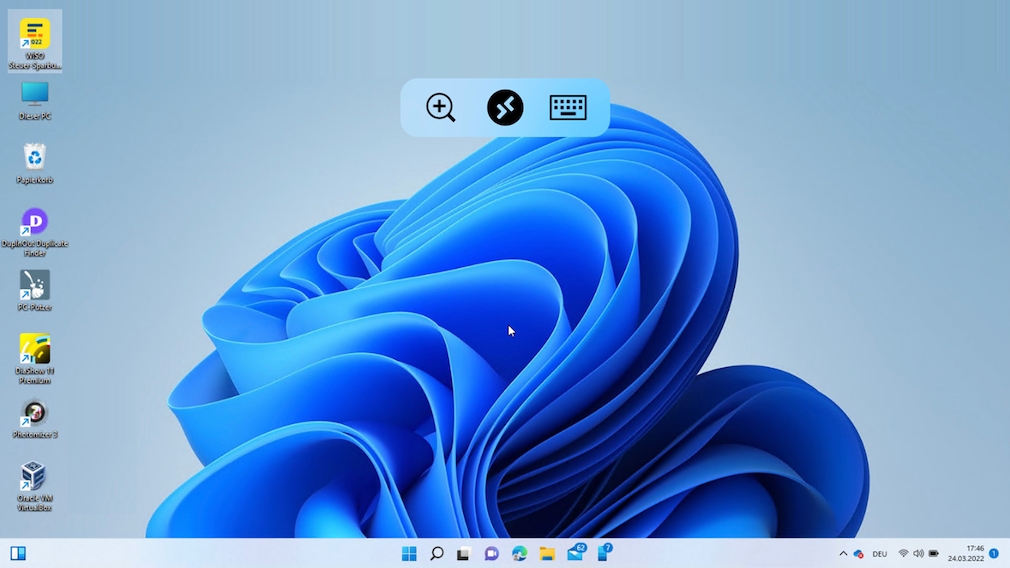Doing something quickly on the PC from the sofa or the garden lounger – for many Windows users this is a dream that is not so unrealistic. Because that’s exactly what Microsoft’s Remote Desktop even has a free app for. The only hurdle for the PC remote control from the mobile phone: The computer needs a Pro version of Windows 11, 10, 8 or 7 and must be in the same network as the mobile device. COMPUTER BILD shows how it works. Depending on the end device, you only need one of these apps:
Microsoft Remote Desktop for Android
Microsoft Remote Desktop for iOS
Remote Desktop: Share PC
First enable the remote desktop function on the computer. It works like this:
- Press Windows key + Ito open Settings.
- click on system and then up remote desktop.
- Set the “Remote Desktop (enable)” switch to “On” and click To confirm.
- click on Select users who have remote access to this PC (Windows 10) or remote desktop user (Windows 11).
- Click on your Windows username. If it is not visible, click first Add to, advanced and Seek nowselect the name from the list and confirm with three clicks OK. Important: Remember the entry under “Use this PC name for connections from the remote device” (Windows 10) or “PC name” (Windows 11).
If you are using an older version of Windows, it works a little differently: press there Windows key + BreakClick on remote settings and tick “Remote Assistance”. Make sure that the option “Allow remote connections to this computer” or “Allow connections from computers” is checked and confirm with if necessary OK. Then select the allowed Windows user as described above. You can find the PC name to be remembered by clicking on computer name.
Remote desktop: connect app
To access your shared PC from the mobile device, proceed as follows:
- Install the Microsoft Remote Desktop app for Android or iOS. On iPhone or iPad, tap after the Open on OK and Further, on Android Accept. Then, if necessary, allow access to the Bluetooth function, the camera and the microphone OK.
- After opening the app, tap the plus sign at the top right, then tap Add PC respectively on AddPC.
- On the iPhone, enter the computer name from the previous section under “PC Name” and confirm with Back as To back up. On Android, go up after a tap Add manually in the same way and then tap directly Save – or just the name of the automatically detected PC.
- To establish the connection with the PC, tap on the new PC symbol with the name noted above and, if necessary, confirm with Connect.
- In the following window, enter your Windows user name and your Windows password and tap on further (iOS) or Continue (Android). The PC desktop then appears on the mobile device as shown in the image below. Since each Windows user can only be logged in once, the lock screen appears on the PC.
To disconnect, tap the middle icon with the two arrows at the top of the app. You will then see the remote PC in a mini window and simply disconnect it with a tap on the X. Alternatively, simply log on to the PC again: The connection is then automatically terminated.

Windows 11 on an iPhone: Use the three icons above to control Windows or disconnect. This also works on edge.
Control Windows remotely via app
When operating the PC via the app, these tips are useful:
- Zoom: In the remote app, the displayed Windows desktop can be zoomed in as usual by pinching two fingers apart or together. Alternatively, use the magnifying glass icon at the top of the screen.
- Move: To move the zoomed section, quickly swipe in the desired direction.
- Text input: With the keyboard symbol at the top right, you can show and hide a screen keyboard for entering text on the PC.
- Click: In the standard view, you cannot simply tap a Windows button like on a smartphone. Instead, move the mouse pointer that appears to the desired area and tap anywhere on the smartphone screen to “click”.
- touch mode: To switch from pointer to touch mode, tap the remote desktop icon with two arrows at the top of the screen, then tap the hand icon in the top left. Use the mouse icon to switch back to the standard view in the same way.
- Right click: For example, to show the desktop context menu, press and hold it. For example, if the smartphone gives haptic feedback, you have pressed long enough.
- End: To disconnect from the PC, tap the remote desktop icon with the two arrows at the top of the screen and close the mini desktop in the top left with X-Character.
Microsoft Remote Desktop for Windows
Microsoft Remote Desktop for Mac
